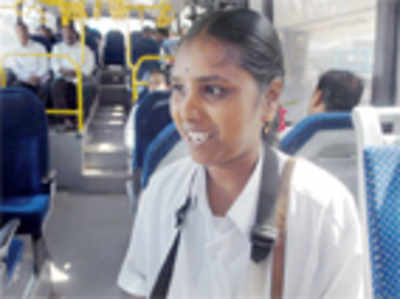Study finds ETMs a pain in the neck for conductors

Of the 300 KSRTC , BMTC staff polled, 37% had moderate neck disability
A study that examined 300 conductors employed with Karnataka State Road Transport Corporation (KSRTC) and Bangalore Metropolitan Transport Corporation (BMTC) found that many of them had some form of neck disability in their most productive years. With KSRTC and BMTC looking at introducing many more electronic ticketing machines (ETMs ) in their buses soon, the study is a timely reminder for the decision-makers of both organisations.
Hand-held ETMs save time and energy in issuingbus tickets to commuters. But the flip side is their effect on the bus conductors who wear these gadgets dangling around their necks. According to the study, ‘Prevalence of Neck Pain in Bus Conductors Using Electronic Gadgets (Ticketing Machine)’ done by physiotherapist Karvir Shruti for her Master of Physiotherapy in Musculoskeletal Disorder and Sports from Padmashree Institute of Physiotherapy, more than half of the ticketing machine-using KSRTC and BMTC conductors surveyed were suffering from some kind of neck and shoulder pain in varying degrees. It found that conductors with minimal disability were 63 per cent of the sample, while those with moderate disability numbered 37 per cent. The result showed that males (75.7%) between the ages 35-40 years (57%), working for eight hours/day (50.7%) and using the gadget for around two to three years (53%) were the worst affected.
Neck Disability Index , which is an internationally recognised standard used by physiotherapists for checking neck pain, and was customised for this particular group.
Shruti explained that these individuals had never been diagnosed or checked for muscular or bone related ailments before. The most mobile part of the spine are the cervical (relating to the neck) and lumbar (lower part of the back) regions. The study found these areas were affected among those surveyed because of the load on the neck, followed by the shoulder region.
“Neck pain is caused by prolonged standing and bearing loads on the neck and shoulder muscles with repetitive movements. Bus conductors stand for a longer duration — almost seven hours a day for several years — with the neck held in a flexed position while issuing tickets to passengers, and they move around the bus. As the neck is prone to flexion most of the time, there are chances of pain and discomfort in the neck due to the strenuous workload. Because of the recent usage of ETMs, this additional weight may have an influence on neck pain in bus conductors,” said H S Mallikarjunaiah, Shruti’s research guide and Assistant Professor of Physiotherapy at Padmashree Institute.
A majority of the conductors who reported moderate disability have been in this field for around 10 years and have been using the ETMs for at least three years.
Mallikarjunaiah said prolonged usage of the gadgets may cause severe disability. Awareness needs to be created among conductors about using these machines. Those who already have problems need to be educated about simple exercises they can do to minimise the pain, he added.
A study that examined 300 conductors employed with Karnataka State Road Transport Corporation (KSRTC) and Bangalore Metropolitan Transport Corporation (BMTC) found that many of them had some form of neck disability in their most productive years. With KSRTC and BMTC looking at introducing many more electronic ticketing machines (
Hand-held ETMs save time and energy in issuing
The assessment was done using the
Shruti explained that these individuals had never been diagnosed or checked for muscular or bone related ailments before. The most mobile part of the spine are the cervical (relating to the neck) and lumbar (lower part of the back) regions. The study found these areas were affected among those surveyed because of the load on the neck, followed by the shoulder region.
“Neck pain is caused by prolonged standing and bearing loads on the neck and shoulder muscles with repetitive movements. Bus conductors stand for a longer duration — almost seven hours a day for several years — with the neck held in a flexed position while issuing tickets to passengers, and they move around the bus. As the neck is prone to flexion most of the time, there are chances of pain and discomfort in the neck due to the strenuous workload. Because of the recent usage of ETMs, this additional weight may have an influence on neck pain in bus conductors,” said H S Mallikarjunaiah, Shruti’s research guide and Assistant Professor of Physiotherapy at Padmashree Institute.
A majority of the conductors who reported moderate disability have been in this field for around 10 years and have been using the ETMs for at least three years.
Mallikarjunaiah said prolonged usage of the gadgets may cause severe disability. Awareness needs to be created among conductors about using these machines. Those who already have problems need to be educated about simple exercises they can do to minimise the pain, he added.
GALLERIES View more photos























